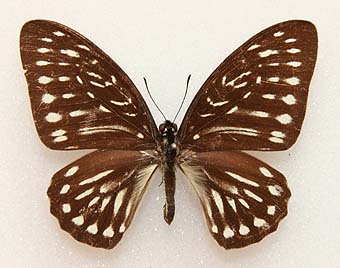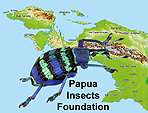

Papua-Insects.nl
The Papua Insects Foundation
The Swallowtails (Lepidoptera: Papilionidae, Papilioninae) of Papua Indonesia
by Jan Moonen
Graphium (Pathysa) felixi (Joicey & Noakes, 1915)
synonymy:
Papilio felixi Joicey & Noakes, 1915: (Schouten Islands)
Papilio thule f. felixi: Bryk,1930 (Biak)
Graphium (Pathysa) thule: Munroe, 1961
Graphium thule f. felixi: D’Abrera, 1971, 1978
Graphium deucalion felixi: Hancock, 1980
Graphium (Pathysa) deucalion: Collins & Morris, 1985 [range includes Biak]
Graphium (Pathysa) deucalion felixi: Bridges, 1988
Graphium thule felixi: Parsons,1998 (Biak)
endemic species!
fig. 1. Graphium felixi, (male; a: upperside; b: underside), Bosnik, Biak (RMNH)
fig. 2. Graphium felixi, (male; a: upperside; b: underside), Bosnik, Biak (RMNH)
fig. 3. Graphium felixi, (female; a: upperside; b: underside), Bosnik, Biak (RMNH)
fig. 4. Graphium felixi, (female; a: upperside; b: underside), "Schouten eilanden" (RMNH)
Taxonomic notes
This taxon is endemic on Biak. It is closely related to G. deucalion (Boisduval, 1836) from Sulawesi and the North Moluccas, more than to G. thule (Wallace,1865) from New Guinea. Hancock (1980) decided to regard this taxon as a subspecies of G. deucalion based on a similarity in the range of one other species: the owl Otus manadensis Quoy & Gaimard. But the range of this owl is in fact more extended to the South Moluccas and the Lesser Sundas. Both are not found on the mainland of New Guinea, only on Biak. Birds, like this owl, can more easily extend their range than a butterfly, like a Graphium can do.
Graphium felixi differs from the three subspecies of G. deucalion from Sulawesi, Peleng Island and Halmahera, Bacan and Ternate, and is in my opinion better to regard as a distinct species. Collins & Morris (1985) state that G.(P.) deucalion is “not known to be threatened” but only from the given range including “Irian Jaya (Biak)” it is clear that they meant also felixi. In fact there is very little known of the occurrence and biology of this this taxon. A remark from Mr. Felix Pratt in J.J. Joicey & G. Talbot, 1916. New Lepidoptera from the Schouten Islands. Trans. Ent.Soc.London 1916 Part I: 65-68. (Papilionidae): “Papilio felixi is found hovering over the mud near the shore. It is not at all common, but its habits are probably much the same as the other thule forms.” Hancock (1980) mentions that he heard from Ray Straatman that the behaviour of G. felixi differs from that of G. thule. It is not clear in what way it differs.
Early stages are so far unknown.
Distribution
STATUS: Endemic on Biak Island. A rare species.
PAPUA LOCALITIES: Biak: Bosnik. Details in gazetteer.
EXTERNAL DISTRIBUTION: none.
DATA SOURCES: RMNH. Literature (see below).
Literature
Bridges, Ch.A., 1988. Catalogue of Papilionidae & Pieridae (Lep.: Rhop.) Published by Ch.A.Bridges, Urbana, Illinois.
Bryk, F., 1930. Papilionidae II (Papilio) in E.Strand Lepidoptorum Catalogus Pars 37:57-510 (II.1930) W.Junk, Berlin.
Collins, N.M. & M.G. Morris, 1985. Threatened Swallowtail Butterflies of the World. The IUCN Red Data Book. vii + 401 pp + 8 pls. IUCN, Gland, Switzerland & Cambridge, U.K.
D'Abrera, B., 1971. Butterflies of the Australian Region. Lansdowne Press Pty Ltd, Melbourne: 415 pp. [idem 1978]
Hancock, D.L., 1980. Systematic notes on Graphium felixi (Joicey & Noakes) (Lep.:Pap.) Aust.ent.Mag. 7(1):11-12 ill. (VIII.1980).
Joicey, J.J. & A. Noakes, 1915. New butterflies and a Moth from Biak. Trans. Ent. Soc. London 63(2):177-197 (?256) Pls.21-28 (5.VIII.1915).
Joicey, J.J. & G. Talbot, 1916. New Lepidoptera from the Schouten Islands Trans. Ent. Soc. London 1916 Part I:65-83, pls.3-6.
Munroe, E., 1961. The Classification of the Papilionidae (Lep.) The Canadian Entomologist suppl.17:1-51 1961
Parsons, M., 1998. The Butterflies of Papua New Guinea. Their Systematics and Biology. Academic Press. San Diego, etc.
